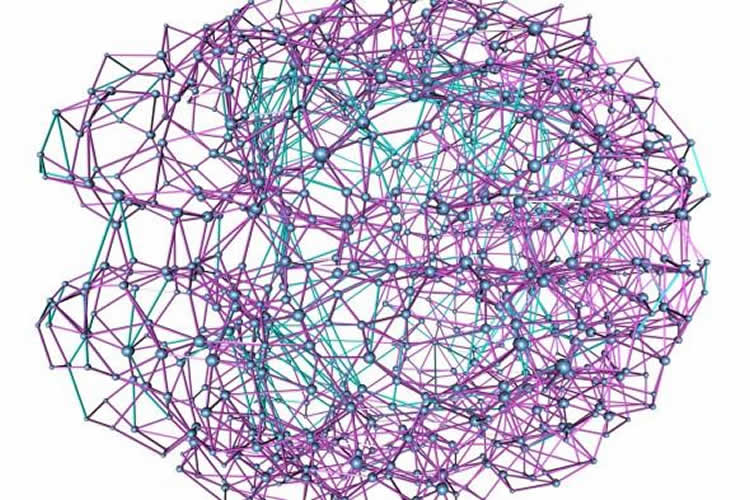Have you ever wondered why the human brain evolved the way it did?
A new study by Northeastern physicist Dmitri Krioukov and his colleagues suggests an answer: to expedite the transfer of information from one brain region to another, enabling us to operate at peak capacity.
The paper, published in the July 3 issue of Nature Communications, reveals that the structure of the human brain has an almost ideal network of connections–the links that permit information to travel from, say, the auditory cortex (responsible for hearing) to the motor cortex (responsible for movement) so we can do everything from raise our hand in class in response to a question to rock out to the beat of The 1975.
The findings represent more than a confirmation of our evolutionary progress. They could have important implications for pinpointing the cause of neurological disorders and eventually developing therapies to treat them.
“An optimal network in the brain would have the smallest number of connections possible, to minimize cost, and at the same time it would have maximum navigability–that is, the most direct pathways for routing signals from any possible source to any possible destination,” says Krioukov. It’s a balance, he explains, raising and lowering his hands to indicate a scale. The study presents a new strategy to find the connections that achieve that balance or, as he puts it, “the sweet spot.”
Krioukov, an associate professor in the Department of Physics, studies networks, from those related to massive Internet datasets to those defining our brains. In the new research, he and his co-authors used sophisticated statistical analyses based on Nobel laureate John Nash’s contributions to game theory to construct a map of an idealized brain network–one that optimized the transfer of information. They then compared the idealized map of the brain to a map of the brain’s real network and asked the question “How close are the two?”
Remarkably so. They were surprised to learn that 89 percent of the connections in the idealized brain network showed up in the real brain network as well. “That means the brain was evolutionarily designed to be very, very close to what our algorithm shows,” says Krioukov.
The scientists’ strategy bucks tradition: It lets function–in this case, navigability–drive the structure of the idealized network, thereby showing which links are essential for optimal navigation. Most researchers in the field, says Krioukov, build models of the real network first, and only then address function, an approach that does not highlight the most crucial links.
The new strategy is also transferable to a variety of disciplines. The study, whose co-authors are at the Budapest University of Technology and Economics, mapped six diverse navigable networks in total, including that of the Internet, U.S. airports, and Hungarian roads. The Hungarian road network, for example, gave travelers the “luxury to go on a road trip without a map,” the authors wrote.
Future applications of the research cross disciplines, too. Knowing what links in a network are the most critical for navigation tells you where to focus protective measures, whether the site is the Internet, roadways, train routes, or flight patterns.
“Conversely, if you’re a good guy facing a terrorist network, you know what links to attack first,” says Krioukov. A systems designer could locate the missing connections necessary to maximize the navigability of a computer network and add them.

In the brain, the links existing in the idealized network are likely those required for normal brain function, says Krioukov. He points to a maze of magenta and turquoise tangles coursing through a brain illustration in his paper and traces the magenta trail, which is present in both the ideal and real brains.
“So we suspect that they are the primary candidates to look at if some disease develops–to see if they are damaged or broken.”
Looking to the future, he speculates that once such links are identified, new drugs or surgical techniques could perhaps be developed to target them and repair, or circumvent, the damage.
“At the end of the day, what we are trying to do is to fix the diseased network so that it can resume its normal function,” says Krioukov.
Source: Jessica Caragher – Northeastern University
Image Credit: Image is credited to Dmitri Krioukov
Original Research: Full open access research for “Navigable networks as Nash equilibria of navigation games” by András Gulyás, József J. Bíró, Attila Kőrösi, Gábor Rétvári and Dmitri Krioukov in Nature Communications. Published online July 3 2015 doi:10.1038/ncomms8651
Abstract
Navigable networks as Nash equilibria of navigation games
Common sense suggests that networks are not random mazes of purposeless connections, but that these connections are organized so that networks can perform their functions well. One function common to many networks is targeted transport or navigation. Here, using game theory, we show that minimalistic networks designed to maximize the navigation efficiency at minimal cost share basic structural properties with real networks. These idealistic networks are Nash equilibria of a network construction game whose purpose is to find an optimal trade-off between the network cost and navigability. We show that these skeletons are present in the Internet, metabolic, English word, US airport, Hungarian road networks, and in a structural network of the human brain. The knowledge of these skeletons allows one to identify the minimal number of edges, by altering which one can efficiently improve or paralyse navigation in the network.
“Navigable networks as Nash equilibria of navigation games” by András Gulyás, József J. Bíró, Attila Kőrösi, Gábor Rétvári and Dmitri Krioukov in Nature Communications. Published online July 3 2015 doi:10.1038/ncomms8651






